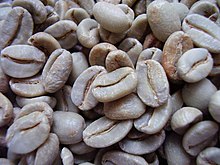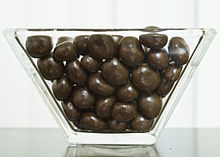Coffee bean

The coffee bean is the seed of the coffee plant , with the drink of coffee is brewed. Botanically, it is not a bean. The word "coffee bean" is a folk etymological loan translation from Arabic قهوة qahwa "coffee" and Arabicبنّ bunn "berry". The fruits are red, cherry-like stone fruits (coffee cherries) with mostly two stone pits. These stone cores are the actual "coffee beans". They lie with their flattened sides to each other and have a longitudinal furrow, the so-called seam , in the middle of this surface . A special form, in which one of the two kernels wither away and only a single, rounded kernel develops, is called the “pearl bean”.
These stone kernels are the seeds of the coffee plants and mostly consist of nutrient tissue that contains caffeine in amounts of around 0.8 to 2.5%.
Coffees belong to the genus Coffea from the Rubiaceae family .
sorts
There are forty different types. In recent decades, however, the range has mainly been reduced to the two varieties Arabica ( Coffea arabica ) and Robusta ( Coffea canephora , Syn. Robusta ).
With 60 percent of world trade, Arabica is the most important type of coffee. It grows mainly in the highlands, for example in Brazil, Kenya and Colombia. The bean is greenish to blue-green, oval in shape and about 9 mm long. It has a curved seam.
Robusta resp. Canephora is faster-growing, more productive and more resilient than the Arabica variety. It grows in areas up to 900 meters in height such as Colombia, Vietnam or Indonesia. Beans of this type are brownish to yellowish green, rounded and smaller than those of Arabica. The seam is straight. Robusta is mainly used as an additive for the preparation of espresso , as it supports the formation of the crema and brings a full body and is very acidic in the taste profile.
The more expensive Arabica (also known as Java bean ) gives a slightly more acidic coffee with less bitter substances and a lighter crema, but with more finer (often described as "fruity") taste nuances. Robusta, on the other hand, often has a little less acidity (due to the less sophisticated flavor gradations, it can be roasted a little longer, which reduces the acidity), tends to be more bitter (good coffees have a fine bitter note as with dark chocolate), gives the darker crema and gives it Coffee its “body” (a somewhat broader taste, a kind of foundation). Ultimately, it is primarily a question of personal taste which mixing ratio you prefer - e.g. B. 60:40 (more southern Italy), 75:25, 90:10 or 100: 0 (more northern Italy) - whereby 100% Arabicas are often perceived as unbalanced by connoisseurs.
Grade
The origin, size and number of defects in the delivery are particularly important criteria for assessing coffee beans.
The origin is mainly about the mounting height. At higher altitudes, the fruits ripen more slowly and the beans grow larger and harder. Common abbreviations in Central and South America are SHB ( Strictly Hard Bean , or SHG for Strictly High Grown ) for growing areas at 1600 meters above sea level and higher, and HB ( Hard Bean ) for regions below.
Coffee beans are sorted according to size during production. Larger beans fetch higher prices in the market because traders assume they have had more time to mature. Sizes are given in 1/64 inch. In international trade, the classification goes from very large (size 20 ≈ 8 mm) through small (size 14 ≈ 5.5 mm) to peaberry (smaller).
To check the quality of the delivery, a random sample is examined for defects. The Brazil method counts the defects in a 300 g sample. Defects are weighted differently. A bad bean counts as a full defect, while a broken bean counts as 1/5. If, on the other hand, a large stone or twig is found, five full defects are noted.
Economical meaning
According to the food and agriculture organization FAO, around 10.3 million t of coffee beans (green) were harvested worldwide in 2018 (without specifying the varieties).
A total of 10.3 million tons of green coffee were harvested worldwide in 2018. The table gives an overview of the 10 largest producers of coffee worldwide, which together reaped 84.6% of world production:
| Harvest quantities in 2018 (in t) coffee beans |
|
|---|---|
| country | harvest |
|
|
3,556,638 |
|
|
1,616,307 |
|
|
722.461 |
|
|
720,634 |
|
|
481.053 |
|
|
470.221 |
|
|
369,622 |
|
|
326,982 |
|
|
245,580 |
|
|
211,200 |
| world | 10,303,122 |
| Source: FAO | |
use
The majority of world production is roasted and ground used in the manufacture of the beverage coffee . In addition, the beans are used for many other purposes.
The roasted beans can also be consumed whole. Candy manufacturers offer them covered with chocolate as a treat. Eating the beans is considered healthy because they are rich in nutrients and vitamins. However, caution is advised with excessive consumption, as larger particles form when chewing than when grinding and the caffeine dissolves more slowly. This means that it takes about half an hour to take effect and last for a few hours.
Coffee is also used in the medical field. Roasted to the point of charring, the beans are turned into coffee charcoal , which is primarily used as a natural remedy for the treatment of diarrheal diseases. Recently, green coffee extract has also been promoted as a miracle cure for obesity and wrinkles. Green coffee can also be made very easily and inexpensively at home.
literature
- Hans Becker , Volker Höhfeld , Horst Kopp : Coffee from Arabia. The change in the meaning of a global economic good and its settlement-geographical consequence on the dry line of ecumenism. (Series: Geography Knowledge. Series of publications for research and practice. Issue 46). Wiesbaden 1979.
Web links
Individual evidence
- ↑ Erdmute Heller: Arabesques and Talismans . CH Beck, 1992, ISBN 3-406-34066-0 , pp. 145 .
- ↑ a b c coffee, green coffee. In: Transport Information Service. Retrieved April 2, 2015 .
- ↑ green coffee. In: KaffeeWiki. Retrieved April 27, 2015 .
- ^ Classification of Green Coffee Beans: Brazil / New York Method. Coffee Research Institute, accessed April 26, 2015 .
- ↑ Production statistics of the Food and Agriculture Organization of the United Nations (FAO) 2018 , fao.org, accessed March 24, 2020
- ↑ Eating coffee beans - is that wrong? July 25, 2014, accessed April 27, 2015 .
- ↑ Coffee charcoal - a medicinal powder not just for the intestines. April 22, 2011, accessed April 27, 2015 .
- ↑ Green coffee. Retrieved April 27, 2015 .
- ↑ Roastrebels: Trendy green coffee drink - effect and preparation. Retrieved March 29, 2019 .
- ↑ Lukas Macheiner, Anatol Schmidt. Matthias Schreiner, Helmut K. Mayer: Green coffee infusion as a source of caffeine and chlorogenic acid. In: Journal of Food Composition and Analysis. Volume 84, 2019 ( DOI ).






